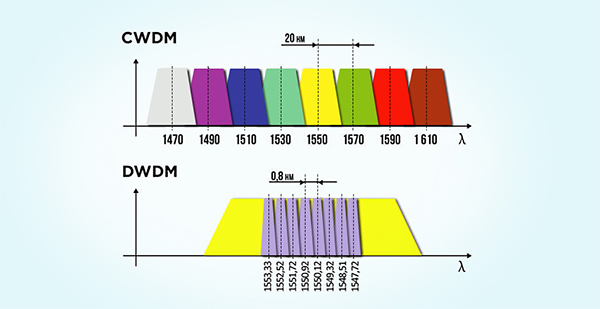What is WDM?
WDM is an abbreviation for wavelength division
multiplexing. It is a technology that multiplexes signals of different
wavelengths together for transmission through optical links. By assigning its
own wavelength to each data stream, multiple data streams can be sent on the
same optical fiber without interference between streams. In this way, WDM
maximizes the use of optical fiber and helps optimize network investment.
What is CWDM and DWDM?
CWDM is the abbreviation of Coarse Wavelength
Division Multiplexer. It can be deployed on most types of fiber optic networks,
and is usually deployed in point-to-point topologies in enterprise networks and
telecom access networks.
CWDM multiplexer modules are available in 4, 8 and 16 channel
configurations. These modules passively multiplex the optical signal output
from multiple electronic products, send optical fibers to them, and then
demultiplex the signals into separate, different signals for input to the
gadget at the other end of the optical fiber link.
DWDM is an abbreviation for Dense Wavelength
Division Multiplexer. In DWDM systems, the number of multiplexed channels is
much denser than CWDM, because DWDM uses tighter wavelength spacing to install
more channels on a single fiber.
DWDM multiplexer/demultiplexer modules are used to multiplex multiple
DWDM channels into one or two optical fibers.
Difference between CWDM and DWDM
Transmission Distance
CWDM transmission distance is shorter than DWDM transmission distance.
Because DWDM wavelength is highly integrated with optical fiber during optical transmission, so DWDM can reach a longer distance than CWDM.
However, CWDM cannot spread over long distances, because CWDM wavelengths
cannot be amplified by EDFA amplifiers, so the CWDM distance is limited to 100
miles (160 kilometers).
Laser
Since the wavelength of the DWDM system is closely spaced, they need to
maintain a more stable frequency than CWDM with wider channel spacing.
Therefore, they need to use cooled lasers, while CWDM systems use uncooled
lasers.
Channel
CWDM has a wider spacing than DWDM. This means that CWDM can support up
to 18 channels, while DWDM can install 40, 80 or up to 96 channels on the same
fiber pair. DWDM has a narrower channel spacing of 0.8/0.4nm, and CWDM uses a
wider channel spacing of 20nm.

Cost
DWDM equipment is usually more expensive than CWDM equipment. However,
due to the popularity of DWDM, the price of DWDM transceivers is lower than
that of CWDM transceivers. Due to the wider CWDM channels, the number of
channels available on the same link is significantly reduced, but the optical
interface components do not have to be as precise as DWDM components.
Therefore, CWDM equipment is much cheaper than DWDM equipment.
Conclusion
Choosing CWDM or DWDM mainly depends on your own needs. If you want to
transmit more data to farther places, then you should choose DWDM. If you only
transmit data over short distances and want to reduce costs, and then choose
CWDM.
Baudcom offers all kinds of WDM products. For more information, please visit Baudcom.